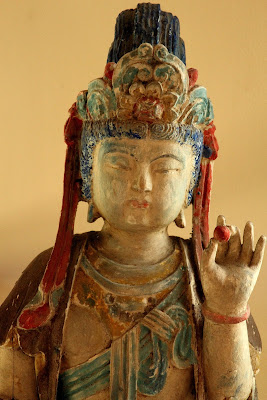We got a three day pass to the temples of Angkor. We thought it would be enough, but it really wasn't. I promised myself I would return in the not too distant future. In the meantime, we tried to make the most of our time there by choosing only three sites to visit. This day it would be Angkor Thom.
Angkor Wat is the City that is a temple, Angkor Thom on the other hand is the Great City, the last capital city of the Angkorian empire. Angkor Thom is a walled and moated city, with it's state temple Bayon, right in the center. There are five entrances to the city and each entrance is crowned by 5 giant faces with their own enigmatic expressions. In accordance with the Khmer belief that the Angkors are a microcosmic representation of the universe, the moat surrounding Angkor Thom are the oceans, the city itself are the mountains and the Bayon temple is Mount Meru.
We entered Angkor Thom through the South Gate, crowned with a giant stone face, giving us a hint of what was to come. While the main entrance, the south gate, to Angkor Wat is guarded by nagas on both sides, this most popular entry point to Angkor Thom is flanked by a row of stone devas, benevolent supernatural beings on the left and a row of stone asuras, forces of chaos on the right. Each row holding a naga as if playing tug of war, this apparently a representation of a Hindu myth, the Churning of the Ocean of Milk.
Angkor Wat is the City that is a temple, Angkor Thom on the other hand is the Great City, the last capital city of the Angkorian empire. Angkor Thom is a walled and moated city, with it's state temple Bayon, right in the center. There are five entrances to the city and each entrance is crowned by 5 giant faces with their own enigmatic expressions. In accordance with the Khmer belief that the Angkors are a microcosmic representation of the universe, the moat surrounding Angkor Thom are the oceans, the city itself are the mountains and the Bayon temple is Mount Meru.
We entered Angkor Thom through the South Gate, crowned with a giant stone face, giving us a hint of what was to come. While the main entrance, the south gate, to Angkor Wat is guarded by nagas on both sides, this most popular entry point to Angkor Thom is flanked by a row of stone devas, benevolent supernatural beings on the left and a row of stone asuras, forces of chaos on the right. Each row holding a naga as if playing tug of war, this apparently a representation of a Hindu myth, the Churning of the Ocean of Milk.
 |
| The South Gate |
 |
| Asuras pulling Naga |
Because of the limited time we had, and because I really wanted to see the stone faces of Bayon, I proceeded straight to the temple. From afar those enigmatic faces are not visible, one sees only a jumble of stone.
But as one draws a little closer, this jumble of stone begins to resolve themselves.
 |
| note the face under the tree branch |
Some say that the faces of Bayon are a representation of the Bodhisattva Avalokitesvara, the embodiment of Buddha's compassion, others say that the faces are representations of Jayavarman VII, it's builder. Once you enter the temple, you are surrounded by these faces, above you, in front of you, beside you and just round the corner.
Serenity, Silence, Stillness, Tranquility, most of all PEACE. That was what I saw in those stone faces.
Later on I was to learn that the Bodhisattva Avalokitesvara, who here in Bayon is represented as the earthly manifestation of Amitbha Buddha or the Lord Who Hears the Cries of the World, takes a female form in China as the Guanyin or the Goddess of Mercy. Discovering this was an ah! ha! moment for me, because I knew I recognized those faces. I have been enthralled by the Guanyin from the first time I saw a statue with that peaceful, enigmatic face.
 |
| wood and plaster Guanyin |
I have a wood and plaster Guanyin statue, bought many, many years ago when we were living in Singapore and I also try to see the giant Guanyin in the Kek Lok Si temple in Penang, when we visit the Island.
After reluctantly leaving the faces, I meant to go see the carvings and bas reliefs but it was a little too hot, so I decided to just take a walk around the temple surrounded as it was with trees. And among the trees, an altar to a giant Buddha.
We left Bayon via the Victory Gate, also crowned with a giant stone face, with the devas and asuras on each side engaged in their never ending task.
Leaving Angkor Thom, I knew I would make every effort to return since there was a lot more of it to be seen. But when I do return, I know that I will also have to see the faces again.















No comments:
Post a Comment